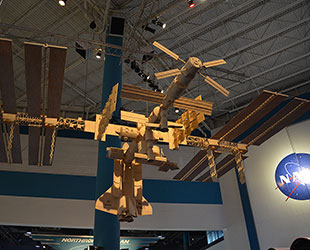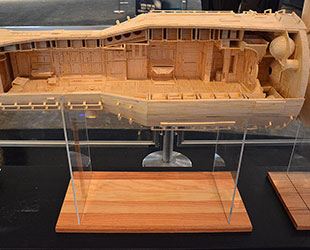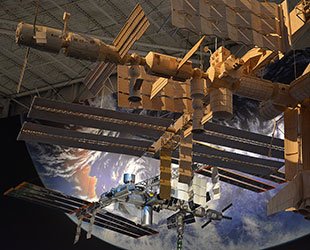 advertisements advertisements
|

|
Ripley's debuts space station made out of 280,000 matchsticks, believe it or not

A matchstick model of the International Space Station is debuting on display as part of "Amazing Universe: The Science of Ripley's Believe It or Not!" at Space Center Houston. (collectSPACE) |
Feb. 20, 2015 – When astronauts describe what they used to assemble the International Space Station, they refer to docking ports, large metal bolts and miles of cabling.
All that artist Patrick Acton needed were 8 gallons of glue and about 280,000 matchsticks, believe it or not.
Acton's 11-foot-long by 15-foot-wide by 4.6 foot tall (3 by 4.5 by 2 meter) space station model may only be one- twenty-sixth (1/26) the size of the orbiting outpost, but is still a sight to behold. Now suspended overhead at Space Center Houston, the visitor complex for NASA's Johnson Space Center in Texas, the matchstick station is part of the new exhibition "Amazing Universe: The Science of Ripley's Believe It or Not!" which opens on Saturday (Feb. 21).
"Patrick Acton has a real interest in the space program," Edward Meyer, vice president of exhibits and archives for Ripley's Believe It or Not!, told collectSPACE at a preview of the exhibit on Wednesday evening. "He said he wanted to make the space station."

Artist Patrick Acton pieced together the space station from more than 280,000 matchsticks held together by glue. (collectSPACE) |
Whereas the actual space station took 13 years to build, Acton needed 1,950 hours, just over 80 days, to assemble his model, matchstick by matchstick.
If put end-to-end, the total number of matchsticks needed for the wooden station would span 7 miles (11 kilometers), or one and a quarter times the height of Mount Everest.
Acton's replica, which is owned by Ripley's, includes the space station's 14 pressurized modules, two robotic arms, four solar panel wings and its backbone truss. In addition, docked to the matchstick marvel* are models of Russia's Progress and Soyuz cargo and crew vehicles, the space shuttle Atlantis, and the European Space Agency's (ESA) recently retired Automated Transfer Vehicle (ATV).
(*Matchstick Marvels is also the name of Acton's museum in Iowa, where he displays his other large-scale wooden creations, including a 200,000 matchstick scale model of the space shuttle Challenger on its launch pad.)

Patrick Acton's 1:13 scale replica of the Russian Zvezda service model features a detailed matchstick interior. (collectSPACE) |
Below the full station, Space Center Houston exhibits two more of Acton's matchstick replicas: one-thirteenth (1/13) scale models of the outpost's Zvezda service module and ESA's first ATV, the "Jules Verne," which resupplied the station in 2008. Not only are these two matchstick models twice as large as their counterparts overhead, but they are also cutaways revealing the detailed interior of both.
Acton made the International Space Station and the two companion cutaway modules for Ripley's Believe It or Not. The models were completed in March 2014 and exhibited at Matchstick Marvels until last June, when Ripley's took ownership of them. They are making their debut as a part of "Amazing Universe: The Science of Ripley's Believe It or Not!" at Space Center Houston.
"This is its world premiere here in Houston," Meyer said. "We've added this to the science show, it is not typically traveling with the rest of the exhibit."
"Amazing Universe," which is open through April 26, also includes an animatronic of the world's tallest human, an example of the world's smallest production automobile and murals of both Albert Einstein and the space shuttle. The portrait of the genius physicist is made completely out of burnt toast, whereas the NASA spacecraft is comprised of computer keyboard keys.

Ripley's matchstick space station model is suspended in front of Space Center Houston's other scale replica of the outpost. (cS) |
"The [Ripley's Believe It or Not!] collection is known for its wonderfully diverse artifacts from across the globe, but Space Center Houston has gone beyond to explore the marvels that lie within space," Richard Allen, the center's president and CEO, remarked. "With an up-close look at meteorites and crystal growth from the International Space Station, this exhibit ignites curiosity and inspires visitors to learn about science."
Acton's International Space Station is the second large model of the outpost on display at Space Center Houston. Hanging just beyond the Ripley's version is a similar-sized but more traditional replica of the orbital laboratory that by comparison makes the matchstick model just a bit more amazing — believe it or not.
For more about 'The Science of Ripley's Believe It or Not!' exhibit, see Space Center Houston's website. |

© 2023 collectSPACE.com All rights reserved.
Questions? E-mail contact@collectspace.com

|
|

|

|
